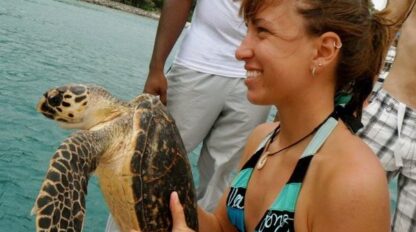The Thrill of Yacht Racing
Yacht racing can be one of the most challenging and enjoyable aspects of sailing. Racing requires absolute teamwork on the part of the crew to achieve smooth boat handling and solid decision-making on the racecourse.
THE RACE COURSE
The course in a traditional sailboat race is set with marks that each boat must go around in a specified manner. The most common racecourse is the port triangle, a course incorporating a windward leg followed by two reach legs and another windward leg. Another course is called windward-leeward, which consists of upwind and downwind legs in succession.
THE START
The starting line, usually set perpendicular to the wind, is between a flag on the race committee boat and a mark or pin. The race committee is in charge of running the race. The start is signaled by the race committee firing a cannon or horn after a three-, five- or ten-minute countdown. The object at the start is to have your boat positioned on, but not over, the starting line when the countdown hits zero. Any boat over the line at the time of the start will be considered a premature starter (“over early”) and must turn back to restart the race.
BASIC BOAT HANDLING AND TACTICS
There are two elements to winning a race: boat handling and tactics. For a team to win a race aboard a large boat, its boat handling skills must be excellent. All tacks must be quick, and the crew must be able to regain speed coming out of a tack by sheeting in the jib quickly. The sails must always be trimmed properly to maintain the fastest possible boat speed. Tactics refer to the strategic choices a crew makes while sailing. These decisions include: where to cross the starting line, which side of the course will offer the best wind, when to tack or jibe, and how to maneuver around the competition.
STRATEGY AT THE START
The starting line consists of a race committee boat and a starting mark or “pin”. The race committee usually places itself so that the imaginary line between itself and the pin is perpendicular to the wind. Such a line insures that all competitors have a fair chance at a good start. Once in place, the race committee begins a 3-, 5-, or 10-minute starting sequence, using a combination of visual and audio signals. During the starting sequence, competitors jockey for position on the line with the goal of being on the line with clean air and boat speed at the start.
THE UPWIND LEG
After the start, sailboat racing becomes a contest to reach the windward mark first. Competitors try to sail as close to the wind as possible while maintaining boat speed and “clean air” (not blocked or spoiled by a leading boat). The key strategy in upwind sailing is to always sail on the lifted tack. Since the wind will shift at different times during the windward leg, the lifted tack will change frequently, and the crew that uses the wind shifts to their advantage should reach the windward mark in good position.
THE DOWNWIND LEG
As on the upwind leg, wind shifts must also be played while sailing downwind. The strategy for the downwind leg is to be on the favored jibe (the one that points the boat closest to the mark while maintaining boat speed) and to maintain clean air.
RACING RULES
In addition to the Right of Way Rule, there are several rules that specifically apply to sailboat racing. The following summarizes the most commonly applied rules for racing:
- Starboard over Port
- Leeward over Winward
- Overtaken over Overtaking
- Buoy Room
The boat with an inside overlap at 2 boat lengths from mark being rounded shall be given room to round the mark by the outside boat. - Luffing a boat
Since the leeward boat has right of way, it may force a windward boat to luff its sails, but must give ample time and opportunity for response. A leeward boat cannot “luff” a windward boat if windward boat has established “mast abeam” (see below)” - Mast Abeam
The helmsperson of the windward boat can resume its course (is no longer forced to head up) when the boat reaches position where a perpendicular line can be drawn between the helmsperson and the mast of the leeward vessel.
INFRACTIONS OF THE RULES
If yacht A “fouls” yacht B by breaking a rule, yacht B’s only recourse is to file a protest stating the infraction with the race committee after the finish. If yacht A admits to a wrongdoing at the time of the infraction, she may prevent the possibility of disqualification later by immediately sailing a “720” (two complete circles) and continuing the race.




